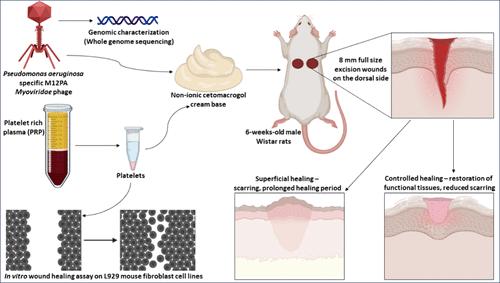Formulation of Dual-Functional Nonionic Cetomacrogol Creams Incorporated with Bacteriophage and Human Platelet Lysate for Effective Targeting of MDR P. aeruginosa and Enhanced Wound Healing
IF 4.6
Q2 MATERIALS SCIENCE, BIOMATERIALS
引用次数: 0
Abstract
Successful development of phage-based therapeutics and their utility predominantly depend on the mode and route of phage administration. Topical and site-directed phage application evokes minimal immune clearance and allows more phage-host adsorption, thereby ensuring higher phage efficacy. However, a notable drawback of conventional topical phage applications is the absence of sustained release. Occlusive emollients guarantee the controlled release of active pharmaceutical ingredients (APIs), thereby facilitating administration, preventing moisture loss, and acting as a skin barrier. In this study, we developed phage and human platelet lysate (h-PL) incorporated cetomacrogol-based creams for combined phage therapy and wound healing. The base material for phage immobilization was formulated by emulsifying paraffin and sterile water with cetomacrogol (emulsifying agent). Specifically, we incorporated a Pseudomonas aeruginosa-infecting lytic phage vB_PaeM_M12PA in the formulation and characterized its genome in this study. Cetomacrogol, a nonionic PEG (polyethylene glycol) based ether, rendered phage stability and allowed initial burst release followed by continuous controlled release of phages from the embedding matrix in the initial 6–8 h. Rheological studies showed that the material has elastic properties with storage moduli (G′) values ranging from 109.51 ± 2.10 to 126.02 ± 3.13 kPa, indicating frequency-independent deformation. Platelet lysates in the cream acted as wound healing agents, and in vitro evaluation of cell migration and wound healing capacity of h-PL showed a significant enhancement by the sixth hour compared to untreated groups. The phage-incorporated cream showed sustained phage release in solid media and a significant reduction in bacterial growth in liquid cultures. In vivo wound healing studies in 6-week-old Wistar rats with full-thickness excision wounds and subsequent histopathological studies showed that the formulation enhanced wound healing and tissue restoration efficiency. In conclusion, the study unveils a promising approach for integrated phage therapy and wound healing strategies.

用噬菌体和人血小板裂解物配制双功能非离子塞托麦克罗格乳膏,以有效靶向 MDR 铜绿假单胞菌并促进伤口愈合
噬菌体疗法的成功开发及其效用主要取决于噬菌体的给药方式和途径。局部和定点噬菌体应用可将免疫清除率降至最低,并允许更多的噬菌体宿主吸附,从而确保更高的噬菌体疗效。然而,传统的局部噬菌体应用的一个显著缺点是缺乏持续释放。闭塞性润肤剂可以保证活性药物成分(API)的控制释放,从而方便用药,防止水分流失,并起到皮肤屏障的作用。在这项研究中,我们开发了噬菌体和人血小板裂解物(h-PL)结合的西托摩芋醇乳膏,用于噬菌体治疗和伤口愈合的综合治疗。用于固定噬菌体的基质材料是通过乳化石蜡和无菌水以及西托摩醇(乳化剂)配制而成的。具体来说,我们在配方中加入了铜绿假单胞菌感染噬菌体 vB_PaeM_M12PA,并在本研究中对其基因组进行了鉴定。流变学研究表明,该材料具有弹性特性,储存模量(G′)值范围为 109.51 ± 2.10 至 126.02 ± 3.13 kPa,表明其变形与频率无关。膏霜中的血小板裂解物可作为伤口愈合剂,体外评估 h-PL 的细胞迁移和伤口愈合能力显示,与未处理组相比,在第六小时时,h-PL 的细胞迁移和伤口愈合能力显著增强。噬菌体包裹的乳膏在固体培养基中显示出持续的噬菌体释放,在液体培养基中细菌生长显著减少。对 6 周大的 Wistar 大鼠全厚切除伤口进行的体内伤口愈合研究和随后的组织病理学研究表明,该制剂可提高伤口愈合和组织修复效率。总之,这项研究为噬菌体疗法和伤口愈合策略的整合提供了一种前景广阔的方法。
本文章由计算机程序翻译,如有差异,请以英文原文为准。
求助全文
约1分钟内获得全文
求助全文
来源期刊

ACS Applied Bio Materials
Chemistry-Chemistry (all)
CiteScore
9.40
自引率
2.10%
发文量
464
期刊介绍:
ACS Applied Bio Materials is an interdisciplinary journal publishing original research covering all aspects of biomaterials and biointerfaces including and beyond the traditional biosensing, biomedical and therapeutic applications.
The journal is devoted to reports of new and original experimental and theoretical research of an applied nature that integrates knowledge in the areas of materials, engineering, physics, bioscience, and chemistry into important bio applications. The journal is specifically interested in work that addresses the relationship between structure and function and assesses the stability and degradation of materials under relevant environmental and biological conditions.
 求助内容:
求助内容: 应助结果提醒方式:
应助结果提醒方式:


